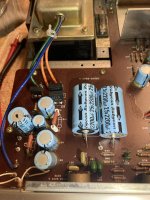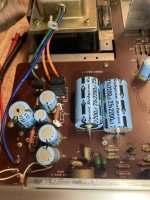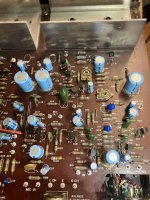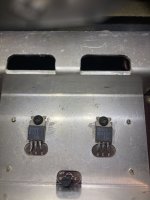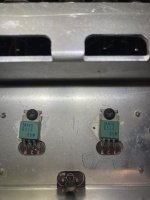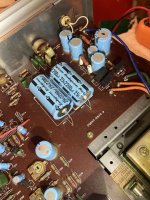G'day everyone,
I am currently working on a Sanyo DCA 200 amp. I'm comfortable ordering replacement capacitors but have never worked on transistors before. I want to replace the 4 main output stage units but am a bit unsure how to go about getting suitable equivalents.
The transistors are marked:
I usually use DigiKey to ship here in Australia so if they stock something that would be good.
If anyone can help me I'd appreciate it.
Cheers



I am currently working on a Sanyo DCA 200 amp. I'm comfortable ordering replacement capacitors but have never worked on transistors before. I want to replace the 4 main output stage units but am a bit unsure how to go about getting suitable equivalents.
The transistors are marked:
- SANYO B514D 91
- SANYO B514D 91
- SANYO D330D 60
- SANYO D330D 60
I usually use DigiKey to ship here in Australia so if they stock something that would be good.
If anyone can help me I'd appreciate it.
Cheers
Use KSD526/KSB596. They are now EOL, but last I looked at Digikey two weeks ago they still had some. The original 2S Toshiba version was the go-to for replacing most TO-220 outputs used in Jap receivers. When those are finally gone, we’ll be stuck using TIP41/2 for this sort of amplifier. There are also several series of 2N devices that are similar, and many would work fine. Most are not that much different from the TIPs and they do make some that are bigger if you were looking to make it more robust at 4 or less ohms. All are higher capacitance than the originals or the recommended replacements so they could scrub off some performance.
Higher speed devices like MJE15030/31 would work. Different problems than TIP41/2 - hard to say which is better. I see 25V rail caps. If the actual voltage is +/-20V or less the D44H8/D45H8 pair can be used as an upgrade. They do not tolerate higher operating voltages, especially if 4 ohm loads are ever used. Very poor second breakdown capability, but work exceptionally well at low voltages.
Higher speed devices like MJE15030/31 would work. Different problems than TIP41/2 - hard to say which is better. I see 25V rail caps. If the actual voltage is +/-20V or less the D44H8/D45H8 pair can be used as an upgrade. They do not tolerate higher operating voltages, especially if 4 ohm loads are ever used. Very poor second breakdown capability, but work exceptionally well at low voltages.
Thanks so much for the quick reply. It's much appreciated.
Great! I have found the KSD526/KSB596 transistors you mentioned in the form of: KSD526Y (NPN) and KSB596YTU (PNP). These are in stock at DigiKey so I'll be ordering them. I'll keep in mind the other options you listed if I'm looking to improve or change again later down the track.
I'm also going to replace the smaller transistors seated below the main output transistors (can be seen in the photo).
Those are 'C536 E5L' - I used https://alltransistors.com/ and did a cross search and found many equivalents that are available on DigiKey - this search process didn't really help when I was trying to track down the Sanyo B514D/D330D equivalent units. Do you just know what to replace them with or is there another way you can manually look up replacements?
Great! I have found the KSD526/KSB596 transistors you mentioned in the form of: KSD526Y (NPN) and KSB596YTU (PNP). These are in stock at DigiKey so I'll be ordering them. I'll keep in mind the other options you listed if I'm looking to improve or change again later down the track.
I'm also going to replace the smaller transistors seated below the main output transistors (can be seen in the photo).
Those are 'C536 E5L' - I used https://alltransistors.com/ and did a cross search and found many equivalents that are available on DigiKey - this search process didn't really help when I was trying to track down the Sanyo B514D/D330D equivalent units. Do you just know what to replace them with or is there another way you can manually look up replacements?
Q17 and Q18? Those are probably the bias transistors (aka the Vbe multiplier) and are nothing special. My guess is the cross ref’s pointed you to a KSC945 (the Korean 2N3904) or KSC/2SC1815 (the most popular Asian transistor ever produced).
The D526/B596 we’re a bog standard Japanese low power output device, used in receivers up to about 30 wpc and as drivers or voltage regulator pass transistors. They will work in place of 99% of the TO-220 or TO-66 silicon outputs from the 70’s, 80’s and 90’s - as long as the originals are not darlingtons. Most of the time they were not. If you can identify complementary driver transistors in between that C536 and the outputs, those Fairchild parts are good to go. Alternatively, measure the voltage between the bases of the two outputs. If it is about 1.1 volts, then they are normal transistors. If it is close to or over 2 volts, then they are darlingtons and another type would be required.
The D526/B596 we’re a bog standard Japanese low power output device, used in receivers up to about 30 wpc and as drivers or voltage regulator pass transistors. They will work in place of 99% of the TO-220 or TO-66 silicon outputs from the 70’s, 80’s and 90’s - as long as the originals are not darlingtons. Most of the time they were not. If you can identify complementary driver transistors in between that C536 and the outputs, those Fairchild parts are good to go. Alternatively, measure the voltage between the bases of the two outputs. If it is about 1.1 volts, then they are normal transistors. If it is close to or over 2 volts, then they are darlingtons and another type would be required.
Just reporting back.
I have completed the capacitor replacement along with replacing the main output stage transistors and the accompanying smaller transistors nearby to them.
Enjoyed the job and replaced the pilot light too. The Sanyo sounds terrific and is nice and clear.
Thanks again for your help with suggesting the replacement parts.


I have completed the capacitor replacement along with replacing the main output stage transistors and the accompanying smaller transistors nearby to them.
Enjoyed the job and replaced the pilot light too. The Sanyo sounds terrific and is nice and clear.
Thanks again for your help with suggesting the replacement parts.
Looks like the NPNs are on one heat sink and the PNPs on the other. Probably so they could get by with NO insulators, collectors of NPN would be on the + supply, and PNPs on the -. That improves heat dissipation capability A LOT, especially with the TO-220. Thermal compound is a good idea. In this case you can use the conductive stuff for CPUs, which is better than the white stuff when you can use it.
Imagine my silly self, having just today purchased one of these. The right channel sounds lovely. The left channel is about half a second of audio before monotonous HUMMMM on either A or B speaker set. The capacitors don' t seem to have spilled their contents. I don't know much about electronics, but I have done a good bit of soldering...
I'll order the transistors mentioned earlier and see how I go.
A question worth asking. My speakers have 4-ohm impedence, I'm using them as near-field monitors and they will rarely get any sort of gain through them. Am i asking for trouble if I do go about replacing the trannies and then try to drive 4-ohm speakers? I'll be sure to hit them with a goodly bit of CPU paste when I do...
I'll order the transistors mentioned earlier and see how I go.
A question worth asking. My speakers have 4-ohm impedence, I'm using them as near-field monitors and they will rarely get any sort of gain through them. Am i asking for trouble if I do go about replacing the trannies and then try to drive 4-ohm speakers? I'll be sure to hit them with a goodly bit of CPU paste when I do...
Attachments
Well, the deadening "HUMMM" is almost completely gone after replacing B514D & D330D. It does threaten to rear it's head every now and then. But mostly it's just static over an ocean of noise. Regardless of input or EQ.
@Reel2Reel What did you end up replacing the accompanying transistors with? They'll be the next thing to try.
@Reel2Reel What did you end up replacing the accompanying transistors with? They'll be the next thing to try.
Just a low level hum, in an otherwise working amplifier, is coming from somewhere besides bad output transistors. The HUMMM that causes is also accompanied by “it wont play music” and “smells like something is getting hot”.
The outputs could be just a little over biased, or might be inherent to the design, if it’s down at the level of the background hiss. REALLLY BAD background static is usually the fault of the transistor at the very INPUT to the power stage. There is a whole list of types from that era to avoid like the plague, example - 2SC458.
If you replace the outputs at all, the bias should be checked and adjusted if possible. The voltage across one of those 0.47 ohm resistors should be in the 10 mV range, give or take a factor of two. Without studying further my best guess is the 500 ohm pot. The right one would be electrically connected to Q17. There is another 1k pot nearby, could be either.
With 4 ohm speakers something close to the original output types will only survive long term if you are gentle with it. No parties, no late night 100 dB jam sessions when the wife is away. If you hear distortion at all, you’re running it too hard. About the only modern-ish types I can recommend for general 4 ohm use are 2N6491 and it’s complement (same as BD911/912). Those saw use in your basic 60 WPC/4 ohm car stereos in the early days when they first started using DC-DC converters in them. TO-3P types are another possibility to bulletproof amps like this. Any modern type intended for audio output use will work. But usually the bias needs to be adjusted DOWN because of their lower Vbe for a given current. The adjustment may fall out of range.
The outputs could be just a little over biased, or might be inherent to the design, if it’s down at the level of the background hiss. REALLLY BAD background static is usually the fault of the transistor at the very INPUT to the power stage. There is a whole list of types from that era to avoid like the plague, example - 2SC458.
If you replace the outputs at all, the bias should be checked and adjusted if possible. The voltage across one of those 0.47 ohm resistors should be in the 10 mV range, give or take a factor of two. Without studying further my best guess is the 500 ohm pot. The right one would be electrically connected to Q17. There is another 1k pot nearby, could be either.
With 4 ohm speakers something close to the original output types will only survive long term if you are gentle with it. No parties, no late night 100 dB jam sessions when the wife is away. If you hear distortion at all, you’re running it too hard. About the only modern-ish types I can recommend for general 4 ohm use are 2N6491 and it’s complement (same as BD911/912). Those saw use in your basic 60 WPC/4 ohm car stereos in the early days when they first started using DC-DC converters in them. TO-3P types are another possibility to bulletproof amps like this. Any modern type intended for audio output use will work. But usually the bias needs to be adjusted DOWN because of their lower Vbe for a given current. The adjustment may fall out of range.
@wg_ski I should clarify; before I replaced the main output stage transistors with the ones you recommended (KSD526/KSB596), Left channel was nothing but a loud monotonous HUMMMM that was unaffected by L/R Balance, Volume, EQ or Input, it was just omnipresent.REALLLY BAD background static is usually the fault of the transistor at the very INPUT to the power stage.
Since replacement, I now have "an ocean of noise with static thundering above it" on the Left channel. The noise and static is more of a foreground thing as it's unaffected by input, balance, volume etc. The Left is passing signal now which is cool, but it's unlistenable due to the noise and static, the static being loud enough that I think I nearly cooked a speaker...
There's a little noise on the phono, which pales in comparison to what's happening on the Left. That might disappear by the time I plug a turntable (and ground) into it.
Also, many thanks for your response. As a Mechanical engineering student, I'm competent with a soldering iron, but about all I know of electronics is "inductors will bite me".
Perhaps I'll downgrade the noise from "ocean" to a "large lake of noise". It seems to be getting better with a bit of use, still unlistenable though.
FWIW, it looks like the left-most of the Q23, Q24 replacements (Q23?) is doing most the heavy lifting. It's putting out more heat than it's sibling.
I hit those pots with a bit of deoxit and them adjusted them while signal was passing to no discernable effect. I'll quickly teach myself about that bias bit and have a bit more of a fiddle.
FWIW, it looks like the left-most of the Q23, Q24 replacements (Q23?) is doing most the heavy lifting. It's putting out more heat than it's sibling.
I hit those pots with a bit of deoxit and them adjusted them while signal was passing to no discernable effect. I'll quickly teach myself about that bias bit and have a bit more of a fiddle.
The original recommendations are the closest types to the originals that you can still get. The beefier ones would result in higher distortion but could be blasted on 4 ohms. None of these old receivers/amps with T0-220 outputs running at or near +/-30 V were ever supposed to be used with 4 ohm speakers (Or more commonly, 2 pairs in parallel). Like modern Sony stuff making 100 watts per channel out of one pair of MT100, they will do it safely if your trigger finger isn’t itchy.
The racket the amp is making is typical of one of those old “low noise” input stage transistors that got moisture-contaminated. It gets in eventually and basically ruins it. Older packaging process - those bugs have been worked out now. Could be any gain stage after the volume control. If you have a scope, just look for the noise. If not, you have to methodically swap them out, one at a time.
The racket the amp is making is typical of one of those old “low noise” input stage transistors that got moisture-contaminated. It gets in eventually and basically ruins it. Older packaging process - those bugs have been worked out now. Could be any gain stage after the volume control. If you have a scope, just look for the noise. If not, you have to methodically swap them out, one at a time.
- Home
- Amplifiers
- Solid State
- Recommendations for replacement transistors - Sanyo DCA 200
